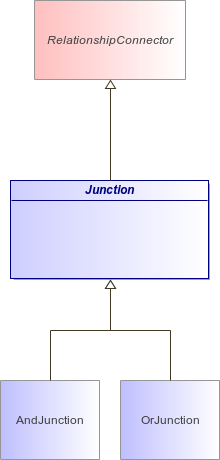
ArchiMate Metamodel
A junction is not an actual relationship in the same sense as the other relationships described in this chapter, but rather a relationship connector.
A junction is used to connect relationships of the same type.
A junction is used in a number of situations to connect relationships of the same type. A junction may have multiple incoming relationships and one outgoing relationship, one incoming relationship and multiple outgoing relationships, or multiple incoming and outgoing relationships (the latter is can be considered a shorthand of two subsequent junctions).
The relationships that can be used in combination with a junction are all the dynamic relationships, as well as assignment, realization, and association. A junction is used to explicitly express that:
- several elements together participate in the relationship (and junction)
- or that one of the elements participates in the relationship (or junction).
A junction should either have:
- one incoming and more than one outgoing relationships,
- or more than one incoming and one outgoing.
Junctions used on triggering relationships are similar to gateways in BPMN and forks and joins in UML activity diagrams. They can be used to model high-level process flow.
